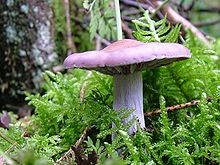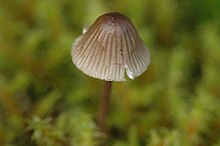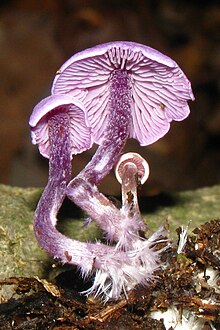List of Tricholomataceae genera
The Tricholomataceae are a family of fungi in the order Agaricales. A 2008 estimate placed 78 genera and 1020 species in the family.[1] Subsequent molecular research, based on cladistic analysis of DNA sequences, has however found that this wide interpretation of the Tricholomataceae renders the family polyphyletic and is no longer tenable.
In 2014, Sánchez-García and colleagues proposed a revised classification of the Tricholomataceae with just seven genera: Leucopaxillus, Tricholoma, Dennisiomyces, Porpoloma, and the newly circumscribed genera Corneriella, Pogonoloma (now moved to the Pseudoclitocybaceae), and Pseudotricholoma.[2]
Of the genera formerly placed in the Tricholomataceae, Amparoina is considered a synonym of Mycena;[3] Callistosporium (with Pleurocollybia as a synonym) and Macrocybe have been moved to the Callistosporiaceae[4] Catathelasma has been moved to the Biannulariaceae;[4] Phyllotopsis and Tricholomopsis to the Phyllotopsidaceae;[5][6] Leucopholiota and Squamanita to the Squamanitaceae;[7] Pseudoclitocybe, Musumecia, and Pogonoloma to the Pseudoclitocybaceae;[8] Cantharellopsis to the Rickenellaceae;[5] Arthromyces to the Lyophyllaceae;[9] and Hygroaster and Melanomphalia to the Hygrophoraceae;[10]
Following changes to the International Code of Nomenclature for algae, fungi, and plants, the practice of giving different names to teleomorph and anamorph forms of the same fungus has been discontinued. As a result two anamorphic genera referred to the Tricholomataceae become synonyms of their teleomorphs: Tilachlidiopsis becomes a synonym of Dendrocollybia and Nothoclavulina a synonym of Arthrosporella.[11]
Currently (2023) the following ten genera are accepted in the Tricholomataceae sensu stricto: Albomagister, Corneriella, Dennisiomyces, Dermoloma, Leucopaxillus, Porpoloma, Pseudobaeospora, Pseudoporpoloma, Pseudotricholoma, and Tricholoma.[12] An additional eleven genera are related, but not yet assigned to a family, and further genera await research.[12] All are listed below.
Genera
[edit]











| Genus | Year | Type species | # of species | Distribution |
|---|---|---|---|---|
| Albomagister Sánchez-García, Birkebak & Matheny[2] |
2014 | Albomagister subaustralis (A.H.Sm. & Hesler) Sánchez-García, Birkebak & Matheny |
3 | Europe, United States |
| †Archaeomarasmius Hibbett et al. |
1997 | Archaeomarasmius leggetti Hibbett et al. |
1 | Extinct, Turonian New Jersey amber |
| Arthrosporella Singer[13] |
1970 | Arthrosporella ditopa (Singer) Singer |
1 | Argentina |
| Asproinocybe R.Heim[14] |
1970 | Asproinocybe lactifera R.Heim |
5 | Africa (tropical) |
| Austroclitocybe Raithelh.[15] |
1972 | Austroclitocybe veronicae Raithelh. |
1 | South America (temperate) |
| Austroomphaliaster Garrido[16] |
1988 | Austroomphaliaster nahuelbutensis Garrido |
1 | South America (temperate) |
| Callistodermatium Singer[17] |
1981 | Callistodermatium violascens Singer |
1 | Brazil |
| Caulorhiza Lennox[18] |
1979 | Caulorhiza umbonata (Peck) Lennox |
3 | USA |
| Cellypha Donk[19] |
1959 | Cellypha goldbachii (Weinm.) Donk |
10 | widespread |
| Clavomphalia E.Horak[20] |
1987 | Clavomphalia yunnanensis E.Horak |
1 | China |
| Clitocybe (Fr.) Staude[21] |
1857 | Clitocybe nebularis (Batsch) P.Kumm. |
300 (approx.) | widespread (esp. north temperate) |
| Collybia (Fr.) Staude[21] |
1857 | Collybia tuberosa Fr. |
3 | widespread (north temperate) |
| Conchomyces Overeem[22] |
1927 | Conchomyces verrucisporus Overeem |
2 | Indonesia |
| Corneriella Sánchez-García[2] |
2014 | Corneriella bambusarum Desjardin & Hemmes |
2 | United States, Thailand |
| Cynema Maas Geest. & E.Horak[23] |
1995 | Cynema alutacea Maas Geest. & E.Horak |
1 | Papua New Guinea |
| Cyphellocalathus Agerer[24] |
1981 | Cyphellocalathus cecropiae (Singer) Agerer |
1 | widespread |
| Delicatula Fayod[25] |
1889 | Delicatula integrella (Pers.:Fr.) Pat. |
2 | widespread (temperate) |
| Dendrocollybia R.H.Petersen & Redhead[26] |
2001 | Dendrocollybia racemosa (Pers.) R.H.Petersen & Redhead |
1 | widespread (temperate) |
| Dennisiomyces Singer[27] |
1955 | Dennisiomyces glabrescentipes Singer |
5 | South America |
| Dermoloma (J.E.Lange) Singer ex Herink[28] |
1959 | Dermoloma cuneifolium (Fr.) Singer |
15 (approx.) | widespread |
| Fayodia Kühner[29] |
1930 | Fayodia bisphaerigera (J.E.Lange) Kühner |
10 (approx.) | widespread (north temperate) |
| Gamundia Raithelh.[30] |
1979 | Gamundia striatula Joss. & Konrad |
6 | Europe, South America (temperate) |
| Infundibulicybe Harmaja[31] |
2003 | Infundibulicybe geotropa (Bull.) Harmaja |
13 | widespread |
| Lepista (Fr.) W.G.Sm.[32] |
1870 | Lepista panaeolus (Fr.) P.Karst. |
50 (approx.) | widespread |
| Lepistella T.J.Baroni & Ovrebo[33] |
2007 | Lepistella ocula T.J.Baroni & Ovrebo |
1 | Central America |
| Leucocortinarius (J.E.Lange) Singer[34] |
1945 | Leucocortinarius bulbiger (Alb. & Schwein.) Singer |
1 | Europe |
| Leucoinocybe Singer[35] |
1943 | Leucoinocybe lenta (Maire) Singer |
1 | Europe |
| Leucopaxillus Boursier[36] |
1925 | Leucopaxillus paradoxus (Costantin & L.M.Dufour) Boursier |
15 (approx.) | Europe |
| Lulesia Singer[13] |
1970 | Lulesia densifolia (Singer) Singer |
3 | tropical |
| Melanoleuca Pat.[37] |
1897 | Melanoleuca vulgaris[N 1] (Pat.) Pat. |
50 (approx.) | widespread |
| Mycenella (J.E.Lange) Singer[38] |
1938 | Mycenella cyatheae (Singer) Singer |
10 | widespread (temperate) |
| Mycoalvimia Singer[17] |
1981 | Mycoalvimia theobromicola Singer |
1 | Brazil |
| Myxomphalia Hora[39] |
1960 | Myxomphalia maura (Fr.) Hora |
4 | widespread (north temperate) |
| Neoclitocybe Singer[40] |
1962 ("1961")[N 2] |
Neoclitocybe byssiseda (Bres.) Singer |
10 | widespread (esp. tropical) |
| Omphaliaster Lamoure[41] |
1971 | Omphaliaster borealis (M.Lange & Skifte) Lamoure |
7 | widespread (north temperate) |
| Omphalina Quél.[42] |
1886 | Omphalina pyxidata (Bull.) Quél. |
50 (approx.) | widespread (esp. temperate) |
| Paralepista Raithelh.[43] |
1981 | Paralepista inversa (Fr.) Raithelh. |
12 | widespread |
| Paralepistopsis Vizzini[43] |
2012 | Paralepistopsis amoenolens (Malençon) Vizzini |
2 | North Africa, southern and southwestern Europe, Asia |
| Peglerochaete Sarwal & Locq.[44] |
1983 | Peglerochaete setiger Sarwal & Locq. |
1 | Sikkim |
| Pegleromyces Singer[17] |
1981 | Pegleromyces collybioides Singer |
1 | Brazil |
| Phaeomycena R.Heim ex Singer & Digilio[45] |
1952 ("1951") |
Phaeomycena aureophylla R.Heim |
5 | Africa, Asia |
| Physocystidium Singer[46] |
1962 | Physocystidium cinnamomeum (Dennis) Singer |
1 | Trinidad |
| Pleurella E.Horak[47] |
1971 | Pleurella ardesiaca (G.Stev. & G.M.Taylor) E.Horak |
1 | New Zealand |
| Porpoloma Singer[48] |
1952 | Porpoloma sejunctum Singer |
12 (approx.) | South America |
| Pseudobaeospora Singer[49] |
1942 | Pseudobaeospora oligophylla Singer |
20 (approx.) | widespread |
| Pseudohygrophorus Velen.[50] |
1939 | Pseudohygrophorus vesicarius Velen. |
1 | Europe |
| Pseudolaccaria Vizzini, Contu & Z.W. Ge[51] |
1939 | Pseudolaccaria pachyphylla (Fr.) Vizzini & Contu |
1 | Europe |
| Pseudolasiobolus Agerer[52] |
1983 | Pseudolasiobolus minutissimus Agerer |
1 | tropical |
| Pseudoomphalina (Singer) Singer[53] |
1956 | Pseudoomphalina kalchbrenneri (Bres.) Singer |
6 | widespread (temperate) |
| Pseudotricholoma Sánchez-García & Matheny[2] |
2014 | Pseudotricholoma umbrosum (A.H.Sm. & M.B.Walters) Sánchez-García & Matheny |
2 | Canada, Europe, United States |
| Resupinatus Nees ex Gray[54] |
1821 | Resupinatus applicatus (Batsch) Gray |
20 (approx.) | widespread |
| Rimbachia Pat.[55] |
1891 | Rimbachia paradoxa Pat. |
10 (approx.) | widespread (tropical) |
| Ripartites P.Karst[56] |
1879 | Ripartites tricholoma (Alb. & Schwein.) P.Karst. |
5 (approx.) | widespread |
| Stanglomyces Raithelh.[57] |
1986 ("1985") |
Stanglomyces taxophilus Raithelh. |
1 | South America |
| Tricholoma (Fr.) Staude[21] |
1857 | Tricholoma equestre (L.) P.Kumm. |
200 (approx.) | widespread (esp. north temperate) |
| Tricholosporum Guzmán[58] |
1975 | Tricholosporum goniospermum (Bres.) Guzmán |
12+ | Northern hemisphere, South Africa, Central America |
Notes and references
[edit]- Notes
- ^ Now a synonym of Melanoleuca melaleuca (Pers.) Murrill.
- ^ Conventional mean to indicate that the taxonomic date of publication for the purpose of priority is different from the date given by the work itself.
- References
- ^ Kirk PM, Cannon PF, Minter DW, Stalpers JA (2008). Dictionary of the Fungi (10th ed.). Wallingford, UK: CAB International. p. 700. ISBN 978-0-85199-826-8.
- ^ a b c d Sánchez-García M, Matheny PB, Gotz DJ (2014). "Deconstructing the Tricholomataceae (Agaricales) and introduction of the new genera Albomagister, Corneriella, Pogonolomaand Pseudotricholoma". Taxon. 63 (5): 993–1007. doi:10.12705/635.635.3. S2CID 86180217.
- ^ Desjardin DE (1995). "A preliminary accounting of the worldwide members of Mycena sect.Sacchariferae". Bibliotheca Mycologica. 159: 1–89.
- ^ a b Vizzini A, Consiglio G, Marchetti M (2020). "Insights into the Tricholomatineae (Agaricales, Agaricomycetes): a new arrangement of Biannulariaceae and Callistosporium, Callistosporiaceae fam. nov., Xerophorus stat. nov., and Pleurocollybia incorporated into Callistosporium". Fungal Diversity. 101: 211–259. doi:10.1007/s13225-020-00441-x. S2CID 211729095.
- ^ a b Olariaga I, Huhtinen S, Læssøe T, Petersen JH, Hansen K (2020). "Phylogenetic origins and family classification of typhuloid fungi, with emphasis on Ceratellopsis, Macrotyphula and Typhula (Basidiomycota)". Studies in Mycology. 96: 155–184. doi:10.1016/j.simyco.2020.05.003. PMC 7388190. PMID 32774511.
{{cite journal}}: CS1 maint: multiple names: authors list (link) - ^ Wang, G. S.; Cai, Q.; Hao, Y. J.; Bau, T.; Chen, Z. H.; Li, M. X.; Yang, Z. L. (2024). "Phylogenetic and taxonomic updates of Agaricales, with an emphasis on Tricholomopsis". Mycology. 15 (2): 180–209.
- ^ Liu JW, Ge ZW, Horak E, Vizzini A, Halling RE, Pan CL, Yang ZL (2021). "Squamanitaceae and three new species of Squamanita parasitic on Amanita basidiomes". IMA Fungus. 12 (1): 4. doi:10.1186/s43008-021-00057-z. PMC 7927255. PMID 33658081.
- ^ Alvarado P, Moreau PA, Dima B (2018). "Pseudoclitocybaceae fam. nov. (Agaricales, Tricholomatineae), a new arrangement at family, genus and species level". Fungal Diversity. 90: 109–133. doi:10.1007/s13225-018-0400-1. S2CID 256065835.
- ^ Bellanger, J.-M.; Moreau, P.-A.; Corriol, G.; Bidaud, A.; Chalange, R.; Dudova, Z.; Richard, F. (2015). "Plunging hands into the mushroom jar: a phylogenetic framework for Lyophyllaceae (Agaricales, Basidiomycota)". Genetica. 143 (2): 169–94. doi:10.1007/s10709-015-9823-8. PMID 25652231. S2CID 15318615.
- ^ Lodge DJ, Padamsee M, Matheny PB, Aime MC, Cantrell SA, Boertmann D, et al. (2014). "Molecular phylogeny, morphology, pigment chemistry and ecology in Hygrophoraceae (Agaricales)" (PDF). Fungal Diversity. 64 (1): 1–99. doi:10.1007/s13225-013-0259-0. S2CID 220615978.
- ^ Stalpers, J.A.; Redhead, S.A.; May, T.W.; et al. (2021). "Competing sexual-asexual generic names in Agaricomycotina (Basidiomycota) with recommendations for use". IMA Fungus. 12 (22): 3. doi:10.1186/s43008-021-00061-3. PMC 8359032. PMID 34380577.
- ^ a b Kalichman J, Kirk PM, Matheny PB (2020). "A compendium of generic names of agarics and Agaricales". Taxon. 69 (3): 425–447. doi:10.1002/tax.12240. S2CID 225585833.
- ^ a b Singer R. (1970). "Omphalinae, Clitocybeae - Tricholomataceae. Basidiomycetes". Flora Neotropica. 3: 17–18. JSTOR 4393664.
- ^ Heim R. (1969). "Breves diagnoses latinae novitatum genericarum specificarumque nuper descriptarum". Revue de Mycologie. 34 (4): 343–47. ISSN 0484-8578.
- ^ Raithelhuber J. (1972). "Lateinische Kurzdiagnosen der auf der Dreiländertagung in Neubulach vorgestellten Pilzarten aus Argentinien. 2". Metrodiana (in German). 3 (1): 27–29.
- ^ Garrido N. (1988). Agaricales s. l. und ihre Mykorrhizen in den Nothofagus-Wäldern Mittelchiles. Bibliotheca Mycologica 120 (in German). Berlin: Cramer. p. 199. ISBN 3-443-59021-7.
- ^ a b c Singer R. (1981). "New Genera of Agaricales". Mycologia. 73 (3): 500–10. doi:10.2307/3759603. JSTOR 3759603.
- ^ Lennox JW. (1979). "Collybioid genera in the Pacific Northwest". Mycotaxon. 9 (1): 117–231. Retrieved 2009-12-01.
- ^ Donk MA. (1959). "Notes on Cyphellaceae: 1". Persoonia. 1 (1): 25–110.
- ^ Horak E. (1987). "Agaricales from Yunnan China I". Nippon Kingakukai Kaiho. 28 (2): 171–88. ISSN 0029-0289.
- ^ a b c Staude F. (1857). Die Schwämme Mitteldeutschlands, in besondere des Herzogthums: xxviii (in German). Coburg. pp. 119, 122, 127.
{{cite book}}: CS1 maint: location missing publisher (link) - ^ van Overeem C. (1927). "Zwamen". In K. Heyne (ed.). De nuttige planten van Nederlandsch Indië, vol. 1 (2nd ed.). Buitenzorg: Departement van Landbouw, Nijverheid & Handel in Nederlandsch-Indië. pp. 62–84.
- ^ Petrini O, Horak E., ed. (1995). Taxonomic Monographs of Agaricales. Bibliotheca Mycologica 159. Berlin: Cramer. p. 159. ISBN 3-443-59061-6.
- ^ Agerer R. (1981). "Contribution to neotropical cyphellaceous fungi: III. The new genus Cyphellocalathus". Mycologia. 73 (3): 486–92. doi:10.2307/3759601. JSTOR 3759601.
- ^ Fayod V. (1889). "Prodrome d'une histoire naturelle des Agaricinés". Annales des Sciences Naturelles Botanique. Série 7 (in French). 9: 181–411. Retrieved 2009-11-29.
- ^ Hughes KW, Petersen RH, Johnson JE, Moncalvo JM, Vilgalys R, Redhead SA, Thomas T, McGhee LL (2001). "Infragenic phylogeny of Collybia s. str. based on sequences of ribosomal ITS and LSU regions". Mycological Research. 105 (2): 164–72. doi:10.1017/S0953756200003415.
- ^ Singer R. (1955). "New species of Agaricales from Pernambuco". Anais da Sociedade de Biologia de Pernambuco. 13: 225–33.
- ^ Herink J. (1958). "Štavnatkovité houby parhorku "Velká Horka" u Mnichova Hradište". Sborník Severoceskeho Musea, Prírodní Vedy (in Czech). 1: 53–86.
- ^ Kühner R. (1930). "Un nouveau groupe d'Agarics leucosporés". Bulletin de la Société Linnéenne de Lyon (in French). 9: 67–72.
- ^ Raithelhuber J. (1979). "Calocybe Kühner – eine Sammelgattung?". Metrodiana (in German). 8 (2–3): 9–10.
- ^ Harmaja H. (2003). "Notes on Clitocybe s. lato (Agaricales)" (PDF). Annales Botanici Fennici. 40 (3): 213–18. Retrieved 2009-11-29.
- ^ Smith WG. (1870). "Clavis Agaricinorum". Journal of Botany, British and Foreign. 8: 246–52.
- ^ Ovrebo CL, Baroni TJ (2007). "New taxa of Tricholomataceae and Entolomataceae (Agaricales) from Central America" (PDF). Fungal Diversity. 27 (1): 157–70. Retrieved 2009-11-27.
- ^ Singer R. (1945). "New genera of fungi. II". Lloydia. 8: 139–44.
- ^ Singer R. (1943). "Das System der Agaricales. III". Annales Mycologici. 41: 1–189.
- ^ Boursier J. (1925). "Leucopaxillus nov. gen". Bulletin Trimestriel de la Société Mycologique de France. 41 (1): 391–93.
- ^ Patouillard N. (1897). Catalogue raisonné des plantes cellulaires de la Tunisie (in French). Paris: Imprimerie Nationale. p. 22.
- ^ Singer R. (1938). "De nonnullis Basidiomycetibus. I". Botanicheskie Materialy Otdela Sporovyh Rastenij Botanicheskogo Instituti Imeni V.L. Komarova. 4 (10–12): 4–18.
- ^ Hora FB. (1960). "New check list of British agarics and boletiPart IV. Validations, new species and critical notes". Transactions of the British Mycological Society. 43 (2): 440–59. doi:10.1016/S0007-1536(60)80067-8.
- ^ Singer R. (1961). "Diagnoses fungorum novorum Agaricalium II". Sydowia. 15 (1–6): 45–83.
- ^ Lamoure D. (1971). "Agaricales de la zone alpine. Rhodocybe borealis Lange & Skifte, et sa position systematique". Svensk Botanisk Tidskrift (in French). 65 (3): 278–82.
- ^ Quélet L. (1887). Enchiridion fungorum in Europa media et praesertim in Gallia vigentium (in Latin). Paris: O. Doin. p. 42. Retrieved 2009-11-29.
- ^ a b Vizzini A, Ercole E (2012). "Paralepistopsis gen. nov. and Paralepista (Basidiomycota, Agaricales)". Mycotaxon. 120: 253–67. doi:10.5248/120.253. hdl:2318/124414.
- ^ Sarwal BM, Locquin MV (1983). Comptes rendus du 108e Congrès national des sociétés savantes, Volume 2: Taxonomie, écologie, phyto-géographie, physiologie végétale, biologie animale (in French). p. 193. ISBN 2735500144.
- ^ Singer R, Digilio AP (1951). "Pródromo de la Flora Agaricina Argentina". Lilloa (in Spanish). 25 (3): 5–461.
- ^ Singer R. (1962). "New genera of fungi. VIII". Persoonia. 2 (3): 407–15.
- ^ Horak E. (1971). "Contributions to the knowledge of the Agaricales s.l. (Fungi) of New Zealand". New Zealand Journal of Botany. 9 (3): 463–93. doi:10.1080/0028825X.1971.10430194.
- ^ Singer R. (1952). "The agarics of the Argentine sector of Tierra del Fuego and limitrophous regions of the Magallanes area". Sydowia. 6 (1–4): 165–226.
- ^ Singer R. (1942). "Type studies on agarics". Lloydia. 5: 97–135.
- ^ Velenovský J. (1939). Novitates mycologicae (in Latin). Prague: L. Souc̆ek. p. 28. OCLC 6325761.
- ^ Vizzini, Alfredo; Ge, Zai-Wei (2015). "Redescription of Clitocybe umbrinopurpurascens (Basidiomycota, Agaricales) and revision of Neohygrophorus and Pseudoomphalina". Phytotaxa. 219 (1): 43–57. doi:10.11646/phytotaxa.219.1.3.
- ^ Agerer R. (1983). "Typusstudien an cyphelloiden Pilzen IV. Lachnellula Fr. s.l". Mitteilungen aus der Botanischen Staatssammlung, München (in German). 19: 164–334.
- ^ Singer R. (1956). "New genera of fungi. VII". Mycologia. 48 (5): 719–27. doi:10.2307/3755381. JSTOR 3755381. Archived from the original on 2015-09-23. Retrieved 2010-12-08.
- ^ Gray SF. (1821). A Natural Arrangement of British Plants. London: Baldwin, Cradock, and Joy. p. 617. Retrieved 2009-11-29.
- ^ Patouillard NT, de Lagerheim G (1891). "Champignons de l'Equateur (Pugillus I)". Bulletin de la Société Mycologique de France (in French). 7: 158–84.
- ^ Karsten PA. (1879). Rysslands, Finlands och den Skandinaviska halföns Hattsvampar. Förra Delen: Skifsvampar. Bidrag till Kännedom of Finlands Natur Folk. Vol. 32. Helsinki: Finska litteratur-sällskapets tryckeri. p. 477.
- ^ Raithelhuber J. (1985). "Die Pilze des Höhenparks Killesberg (Stuttgart). 2 Teil". Metrodiana (in German). 14: 27–41.
- ^ Guzmán G. (1975). "Un nuevo genero y dos nuevas especies de Agaricaceos Mexicanos" (PDF). Boletín de la Sociedad Mexicana de Micología (in Spanish). 9: 61–66.
